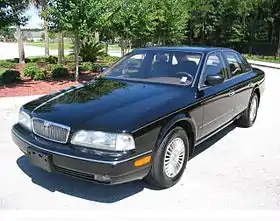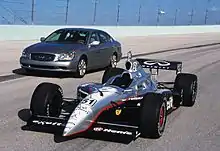| Infiniti Q45 | |
|---|---|
 | |
| Overview | |
| Manufacturer | Infiniti (Nissan) |
| Production | August 1989 – 2006 |
| Assembly | Japan: Kaminokawa, Tochigi |
| Body and chassis | |
| Class | Full-size luxury car |
| Body style | 4-door sedan |
| Layout | Front-engine, rear-wheel-drive |
| Related | Nissan President |
| Chronology | |
| Successor | Infiniti Q70L |
The Infiniti Q45 is a full-size luxury sedan manufactured and marketed by Nissan's Infiniti brand for model years 1989-2006, over three generations.
The first generation Q45 (1989–1999) was based on the Nissan President; the second generation (1997–2000) and third generation (2002–2006) were based on Nissan's JDM Nissan Cima. Exports of the Q45 ended after MY 2006.
First generation (G50; 1989–1996)
| First generation (G50) | |
|---|---|
 1994-1996 facelifted version | |
| Overview | |
| Also called | Nissan Infiniti Q45 (Japan and Australia)[1] |
| Production | August 1989 – June 1996 |
| Model years | 1990–1996 |
| Designer | Shunji Yamanaka (1987)[2][3] |
| Body and chassis | |
| Related | Nissan President |
| Powertrain | |
| Engine | 4.5L VH45DE V8 |
| Transmission | 4–speed automatic |
| Dimensions | |
| Wheelbase | 1990–91: 2,875 mm (113.2 in) 1992–96: 2,880 mm (113.4 in) |
| Length | 5,090 mm (200.4 in) |
| Width | 1,825 mm (71.9 in) |
| Height | 1990–1993: 1,430 mm (56.3 in) 1994–1996: 1,425 mm (56.1 in) |
| Curb weight | 1,780–1,840 kg (3,924–4,057 lb) |
The first generation Q45 came to market in 1989 as a 1990 model with a high-output 4.5 L V8 engine rated at 278 hp (207 kW) and 292 lb⋅ft (396 N⋅m) in North American trim. All Q45s included a VLSD (viscous limited-slip differential), as part of a multi-link suspension. At the time, Nissan was working on a program called the "901 Movement," with the aim of making Nissan's the best handling lineup in the industry.[4] In Japan, it was marketed as the Nissan Infiniti Q45, and was exclusive to Nissan Prince Store locations, as its platform twin the President was exclusive to Nissan Motor Store locations.


Equipment included a Bose sound system, leather interior, power adjustable front passenger seats with two position memory feature that also electrically adjusted the steering wheel, exterior mirrors, one-touch power windows, digital climate control, and keyless entry system.
Revisions in 1993 included 17:1 steering (except on the Q45t, which retained the original 15.1:1 ratio), lower ratio 1st and 2nd gears, and a dynamically smooth suspension, thicker glass, keyless remote, auto-dim rear-view mirror, dipping side view mirrors, revised transmission heat exchanger and external ATF filter, revised oval intake ports and revised disc injectors, fog lights and metal-backed camshaft timing chain guides.
Infiniti offered the Q45 in three trim levels: base, Q45t, and Q45a. The Q45t and Q45a featured a multi-link suspension at both the front and rear wheels, and included a rear stabilizer bar (with the Q45a model being larger in diameter) and both models having a 1 mm smaller in diameter front sway bar, rear spoiler, BBS forged alloy wheels, 4-wheel steering. HICAS and the faster steering ratios was discontinued in the 1995 Q45t model and the Q45a model was not imported in 1996. 1996 models do not feature variable valve timing like the 1990-1995 models do. OBD-II was added for the 1996 model year.
In 1989 (as a 1990 model) a full "active suspension (FAS)" was introduced. It employed 10 sensors sending signals to microprocessor-controlled hydraulic actuators at each wheel. It was designed to reduce body roll, dive and pitch and was very similar to Mercedes-Benz's Active Body Control, which was introduced in 1999 on the C215 CL-Class.
The contemporary upstart luxury marque Lexus (Toyota) had managed to challenge the establish dominance of European full-size luxury cars with the LS 400, so the Q45 seemed poised for similar success with comparable specifications and price to the LS 400 while featuring more emphasis upon handling. However Q45 sales didn't take off which was attributed to the car's unconventional styling, particularly the grille and lack of interior woodgrain or chrome trim. There was also an unusual advertising campaign which did not include actual photos or information about the car.[5][6]
In 1993 the Infiniti brand was launched in Australia with the sole model on offer being the Q45. With a price of A$140,000, the Q45 sold poorly and the brand was subsequently withdrawn from the market in 1996.[7][8] The G50 chassis continued in production in Japan until 2002 as the President in both regular and extended wheelbase versions. The Japanese version had many options that never appeared on the North American G50.
.jpg.webp)
Second generation (Y33; 1997–2000)
| Second generation (Y33) | |
|---|---|
 | |
| Overview | |
| Also called | Nissan Cima |
| Production | July 1996 – December 2000 |
| Model years | 1997 – 2001 |
| Designer | Itaru Sugino (1993) |
| Body and chassis | |
| Related | Nissan Cedric Y33 Nissan Gloria Y33 Nissan Leopard Y33 |
| Powertrain | |
| Engine | 4.1 L VH41DE V8 |
| Transmission | 4-speed automatic with manual shift |
| Dimensions | |
| Wheelbase | 2,830 mm (111.4 in) |
| Length | 1996-99: 5,056 mm (199.1 in) 2000-01: 5,069 mm (199.6 in) |
| Width | 1,820 mm (71.7 in) |
| Height | 2000-01: 1,445 mm (56.9 in) 1996-99: 1,450 mm (57.1 in) |
The second generation Q45 was a lightly revised variant of Nissan’s JDM Nissan Cima, using the Cedric / Gloria platform. For the prior generation, the Q45 took its name from its 4.5-liter V8; the nameplate remained though the second generation, which featured a 4.1 L VH41DE engine producing 267 hp (199 kW) and acceleration figures of 0-60 mph (97 km/h) in about 7.5 seconds. Styling featured an inverse curve C-pillar, and a pronounced full-length horizontal character beltline.
The Q45 Anniversary Edition, limited to 3,000 units, offered highest trim level available for the second-generation Q45, available on 2000 models and standard on the 2001 models. The package included all features of the Q45t model along with “Anniversary Edition” markings on the tailgate badge, ignition key, front seat embossing and floor mats as well as genuine wood trim, wood tone/leather steering wheel, special bright machine finish 17-inch performance wheels and exclusive body color door handles.
The Q45t featured 17-inch wheels and tires, electronically modulated performance-tuned suspension, blackout grille, blackout headlight treatment, performance style steering wheel and “t” badging on the rear decklid.
The Q45 front and rear fascias were slightly revised for 1999; HID headlights and an analog clock became standard equipment. 17" wheels and an electronic adjustable suspension became standard on the Q45t.
Standard features for the second-generation Q45 included traction control, leather interior with faux wood trim, single (later dual) zone climate control, Bose audio system with eight speakers and in-dash single disc CD player, auto dimming rear view mirror, automatic light on and delay off timer, steering wheel-mounted cruise control and head unit controls. Also standard was a memory system for the driver's seat and steering wheel. Options included an integrated satellite navigation system, 6-disc CD autochanger and heated seats.
Nearly all Infinitis before or since have used a two-digit number following a letter to indicate displacement; the second-generation Q was an exception (as was the Nissan Pathfinder clone QX4).

Model Year Changes[9]
- 1998 New front seatbelt pretensioners, mechanical odometer replaced with a liquid crystal display unit from January 1998 production.
- 1999 New standard features included power rear-window sunshade, power trunklid pull-down, and high-intensity xenon gas headlights. Touring edition (Q45t) gained dual-mode electronically controlled shock absorbers.
- 2000 New active front head restraints; rear child-seat anchors; one-touch open/close operation for the standard moonroof and all power windows. A newly optional nav system with dashboard touch-screen replaced a simpler, non-video system. The 10th Anniversary Touring edition had machine-finish wheels, special badges and upholstery, wood/leather steering wheel, and bird’s-eye maple interior accents. New platinum-tip spark plugs.
- 2001 Body-color door handles, bird’s-eye maple interior trim, and a leather/simulated-wood steering wheel were the only changes for 2001.
Third generation (F50; 2001–2006)
| Third generation (F50) | |
|---|---|
 | |
| Overview | |
| Also called | Nissan Cima/President |
| Production | January 2001 – 2006 2001 – 2008 (Middle East) 2005–2008 (South Korea) |
| Model years | 2002–2006 |
| Designer | Mamoru Aoki (1998) Yasuhiro Tani (facelift: 2003)[10] |
| Powertrain | |
| Engine | 4.5 L VK45DE V8 |
| Transmission | 5-speed automatic |
| Dimensions | |
| Wheelbase | 2,870 mm (113.0 in) |
| Length | 2001-04: 5,069 mm (199.6 in) 2004-06: 5,101 mm (200.8 in) |
| Width | 1,844 mm (72.6 in) |
| Height | 2001-04: 1,495 mm (58.9 in) 2004-06: 1,490 mm (58.7 in) |
_V8_rear_10.27.18.jpg.webp)
Introduced as a concept at the 2000 New York Auto Show, the Q45 was completely redesigned for 2002, heavily based on the JDM Cima. The Q45 featured a new 340 hp (253 kW) 4.5 L VK45DE V8 engine, HID headlights, a 5-speed automatic transmission with overdrive.
Development began in 1996, with exterior designs under Mamori Aoki frozen in 1998 and patented in March 2000.[11][12] It was the first Infiniti with laser autonomous cruise control system.
1129 Q45s were sold in the United States for 2005. The 3rd generation Q45 reviewed by Car and Driver, Edmunds and Consumer Guide, receiving relative positive reviews.[13][14][15][16]
The 2003 model received a revised security system, numerically higher final drive ratio (for better acceleration - decreased highway fuel economy), reprogrammed TCU, and a mid-year satellite radio option. The CD changer could load CDs directly at the dashboard head unit.
Standard equipment included a leather interior, power sunroof, 8-way power front seats, remote keyless entry, rain-detecting wipers and side curtain airbags. Standard electronics include: CD, 8 speaker Bose audio system, trip computer, rear view parking camera system, and voice-activated navigation system. The 2002 Q45 was the first vehicle to ever offer voice-activated navigation controls and a reverse parking camera outside Japan, following the JDM 1991 Toyota Soarer. The car seated five passengers and was offered at MSRP of US$56,200 (equivalent to $91,438 in 2022).
A5 Premium option package includes adjustable suspension, 18-inch 8-spoke titanium-color sport alloy wheels, 245/45R18 V-rated tires, rear monitor, rear power sunshade and rear door manual sunshades, climate controlled front seats with heating and cooling functions and perforated leather inserts, navigation system with 7.0-inch LCD display, Intelligent Cruise Control, satellite radio, auto open/close trunk, heated power-reclining rear seats with memory, rear controls for audio and HVAC and rear HVAC vents in B-pillar and front seatback grips — and available chrome-finished 18-inch wheels in place of the titanium wheels.
The 2005 Q45 received revised front and rear fascias, hood, grille, trunk decklid and finisher, headlights, revised exterior chrome trim, integrated fog lights and LED taillights, recontoured double-stitched seating, white luminescent gauge markings, genuine metal knobs for accessory controls, a darker shade of maple interior trim, recalibrated transmission and new 17" alloy wheels.



Replacement
The Infiniti Q45 was no longer exported to the USA after 2006, being unintentionally replaced by a newly redesigned Infiniti M35/45. While the M is a mid-luxury (executive) car that has a shorter length than the Q45, it boasts more interior room, greater performance, a superior rear multilink suspension and front double wishbone, and much friendlier ergonomics, so it succeeded the Q45 as Infiniti's flagship.
A new Q flagship was anticipated by the end of the 2000s decade. According to Mark Igo, the general manager of Infiniti North America, "the new Q will make the brand better, but it is questionable whether it will be very profitable".[17]
Infiniti introduced the next iteration of its flagship, the Y51 series Infiniti M37/56/Nissan Fuga in November 2009. Continuing as a mid-luxury car, the new Infiniti M is only 50 mm (2.0 in) shorter than the final generation Q45, with the same width dimensions of 1,845 mm (6.1 ft) and height of 1,515 mm (5.0 ft) compared to the F50 series Cima of 1,490 mm (4.9 ft) height.
By August 2010 the Nissan Cima, on which the final generation Q45 essentially was based, had been discontinued in Japan, along with its Nissan President sibling. This made the second generation Nissan Fuga the marque's top-of-the-line flagship sedan. When the Fuga assumed the role as flagship sedan of Nissan Japan August 2010, it became the first time that Nissan didn't sell a premium luxury V8 sedan in Japan, although the Fuga's North American cousin, the Infiniti M56, is offered with a V8 shared with the Infiniti QX56.
In May 2012, Nissan released a new version of the Cima in Japan, based on the Fuga Hybrid (Infiniti M35h).[18]
On 17 December 2012, Infiniti announced that all of its future sedan offerings will use the Q prefix, starting from the Q50 as a G37 replacement, Q70 for its M35/45/56 replacement, and a rumored Q80 for the new flagship model.[19]
References
- ↑ Tony Davis, The New Car Buyers Guide No 6, Australia's Premier Passenger Car Guide, 1994, page 174
- ↑ Hsu, Ben (13 November 2014). "25 YEAR CLUB: The Infiniti Q45 is officially a Japanese Nostalgic Car".
- ↑ "山中俊治 - 日本デザインコミッティー".
- ↑ "History of the Car Selection: Nissan Infiniti Q45" (PDF). Gazoo.com (in Japanese). Toyota Motor Corporation. Archived from the original (PDF) on 2004-11-17.
- ↑ "Infiniti water commercial". Youtube. Retrieved 2 February 2017.
- ↑ "Infiniti Launch Commercial". Youtube. Retrieved 2 February 2017.
- ↑ "Next Car's prediction of Infiniti's local release confirmed". Next Car. 22 March 2011. Retrieved 14 March 2012.
- ↑ Fallah, Alborz (18 May 2006). "Nissan to bring the Infiniti Brand to Australia?". CarAdvice. Retrieved 14 March 2012.
- ↑ "1997-01 Infiniti Q45". Consumerguide.com. 16 July 2014.
- ↑ "Home". Archived from the original on 5 July 2006. Retrieved 15 July 2015.
- ↑ "Nissan Shows Early Fruits Of Renault Union". tribunedigital-chicagotribune. Retrieved 15 July 2015.
- ↑ Michael Frank (5 February 2001). "Infiniti's Q Factor". Forbes. Retrieved 15 July 2015.
- ↑ "Cadillac DTS vs. Jaguar S-type 4.0, M-B E430, Infiniti Q45, Lexus GS430, Audi A6 4.2 Quattro, BMW 540i - Comparison Tests". Caranddriver.com. Retrieved 2011-07-31.
- ↑ "Sports Sedans Supreme: 2007 Maserati Quattroporte Executive GT vs 2007 Audi S8 vs 2007 Mercedes-Benz S63 - Latest News, Features, and Road Tests - Automobile Magazine". Automobilemag.com. 2010-12-13. Retrieved 2011-07-31.
- ↑ "BMW 760Li, Mercedes-Benz S63 AMG, Porsche Panamera Turbo - Luxury Sport Sedan Comparison - Automobile Magazine". Automobilemag.com. 2010-12-13. Retrieved 2011-07-31.
- ↑ "Entry-Level Fullsize Luxury Sedan Comparison". Motor Trend. 2010-12-13. Retrieved 2011-07-31.
- ↑ "New Infiniti Q flagship still in doubt - MotorAuthority - Car news, reviews, spy shots". MotorAuthority. Retrieved 2009-06-25.
- ↑ "Nissan Releases All-New Cima". Archived from the original on 2016-03-03. Retrieved 2012-12-29.
- ↑ "Infiniti Unexpectedly Changing All Model Names to Q, QX for 2014, Confirms New Range-Topping Sedan". Car And Driver. 17 December 2012. Retrieved 2013-03-21.